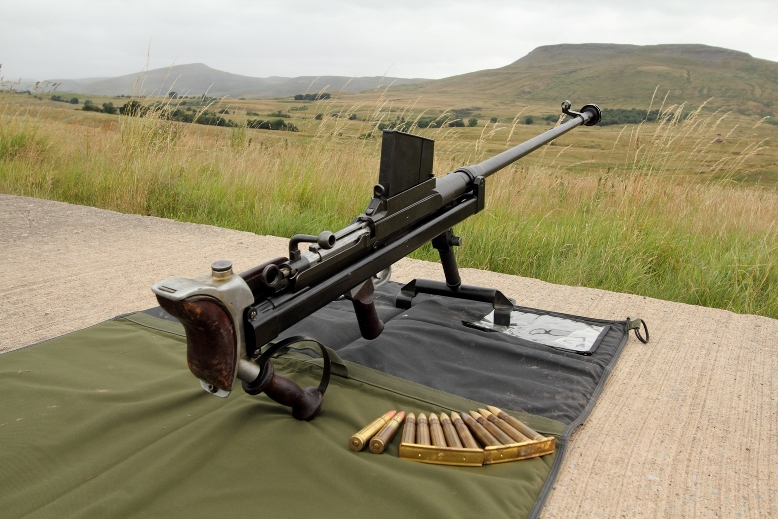As you can no doubt have figured out by the title. That the Russians are always some really bad neighbors to have around.
Anyways this is a pretty good video if you have the time to watch. Grumpy
The Anti-Tank Rifle



Now I have seen one of these puppies fired off once at the local range. (It was a Boys by the way that was rebarreled to 50 BMG) To say that it made some serious noise pollution would be a massive understatement.

It was also just devastating to the steel targets out at the 300 yd range too. As it just punched holes thru them like they were made of cheap plastic instead of hardened steel.
Bottom line – Who ever used these monsters must of had solid brass teasticles. With some arms of like Hercules as they are a light weapon. As I would really hate being made to carry one on a route march!
Here is some more information about these really bad boys.
Grumpy
Anti-tank rifleFrom Wikipedia, the free encyclopedia
|
An anti-tank rifle is a rifle designed to penetrate the armor of vehicles, particularly tanks. The usefulness of rifles for this purpose ran from the introduction of tanks in World War I until the Korean War.
While medium and heavy tank armor became too thick to be penetrated by rigid projectiles from rifles that could be carried by a single soldier, anti-tank rifles continued to be used against other targets.
though recoilless rifles and rocket-propelled grenades such as the bazooka were also introduced for infantry close-layer defense against tanks. Anti-materiel rifles of today, such as the Barrett M82, are a development of the Second World War technology.
|
Contents
History
The tug of war between armour and projectiles had been developing for a long while among naval vessels, since the advent of the Ironclad.
It wasn’t until soldiers met armoured vehicles that the conflict of infantry firearms and armour began.
The introduction of armoured cars and tanks resulted in the development of the first anti-tank weapons, among the first of which were high-powered rifles.
These had appeared in the 19th century for big-game hunting. The anti-tank rifle followed the same route: a large bullet with a high velocity and the ability to penetrate armour.
World War I

Mauser 1918 T-Gewehr 13.2x92mm anti-tank rifle at the Musée de l’Arméein Paris.
The first tanks, beginning with the British Mark I launched against the German trenches in World War I, were nearly impregnable to ordinary rifle fire.
Most armoured cars were similarly protected, but troops rarely faced armoured cars, as they could not navigate the landscape of trench warfare very well.
Though tanks and armoured cars were vulnerable to artillery, mortars, and grenades, infantry was at a significant disadvantage when facing armoured fighting vehicles since they had no effective direct fire weapon, with the exception of the ubiquitous trench mortar, improvised on the spot.
In the direct fire mode, this weapon was manhandled by German infantry over the front of a trench wall and fired at low angles by eye at approaching enemy vehicles.
Though somewhat effective, these actions were obviously very hazardous to any desperate mortar crew as their exposure could attract enemy fire.[1]
The first attempt at boosting penetrating power was the so-called ‘reversed bullet‘. This used the same cartridge and bullet as the regular round, but the bullet was “reversed” and an increased propelling charge was used.
The next development was a special armour-piercing bullet, the K bullet (in German Patrone SmK Kurz 7.92 mm), which could also be fired from the regular infantry rifle.
It had an increased propelling charge and a steel core bullet. This had about a 30% chance of penetrating the 8 mm armour of contemporary tanks if it struck the armour at a perpendicular angle.
Both types had their specific advantages and disadvantages: for example, the K bullet was more expensive to produce and therefore was generally only issued to snipers and other advanced marksmen who could use it more effectively;
the ordinary infantryman had to make do with reversed bullets, which were far less effective and had to be used in closer proximity to the target.
In addition, both types of round damaged the rifles due to the higher propellant load and the resulting higher muzzle velocities and pressures: firstly, service life of the rifle barrel was decreased significantly because of the increased wear.
Secondly, the higher pressure created in the chamber could jam the bolt, leading to the extractor claw failing to extract the cartridge and only breaking off the cartridge rim, leaving it stuck in the chamber.
The strain of firing the increased charge could also burst the chamber of weaker and older rifles, at best destroying the rifle and at worst injuring or killing the rifleman.
For these reasons, the K bullet and reversed bullet were not popular with the troops. Nevertheless, it gave the infantry a chance to stop a tank in an emergency, or at least injure or kill some of the crew if a bullet penetrated.
Even as the rounds were introduced, tanks were being designed and built with thicker armour rendering these rounds largely ineffective, though they remained in use against the older designs and armoured cars.
Hence, a purpose-built weapon was required to counter the newer tanks.
The first purposely-designed infantry anti-tank rifle was designed by Germany. The Mauser 1918 T-Gewehr large-calibre (13.2mm) rifle was capable of penetrating the armour of the newer generations of tanks and allowed a chance at stopping them.
The high recoil of the rifle was very hard on the firer, sometimes breaking the collar bone or dislocating the shoulder.
Although the rifle was unique to its role, it was a development of the Mauser rifles and high-powered British sporting rifles that had preceded it.
The 13.2x92mm (0.538 in) cartridge was not unusual either, as some 0.50in firearms have already been fielded in land warfare with the relatively new and more powerful (as compared to black powder) smokeless powders of the era.
At the same time, in the US, a half-inch high velocity round was being developed for use against aircraft. It would be used with the Browning-designed .50 calibre machine gun.
This round was based on current US .30-06 calibre infantry ammunition. When word of the German anti-tank shell spread, there was some debate as to if it should be copied and used as a base for the new machine gun cartridge.
However, after some analysis the German ammunition was ruled out, as its performance was inferior to the modified Springfield .30-06 round and was semi-rimmed, making it difficult to feed into an automatic weapon.
The Browning M2 .50 cal machine gun would, however, go on to function as an anti-armour machine gun.
World War II

Polish Kb ppanc wz.35 7.92 mm anti-tank rifle used by the Polish Armyin defence of Poland (September 1939).
At the start of World War II, only some European nations had an anti-tank rifle based on a high-velocity, large-calibre round, such as the British Boys anti-tank Rifle.
The first combat use of anti-tank rifles took place during the Invasion of Poland of 1939. The Wz. 35 anti-tank rifle was extensively used by most Polish units. The Wz. 35 with 7.92 mm anti-tank rifle ammunition was a very effective weapon against all German tanks of the period (the Panzer I, II and III, as well as the Czech-made LT-35 and LT-38).[2]
At up to 400 meters, it could destroy all lightly armoured vehicles. It could penetrate 15 mm of armour, sloped at 30° at 300 m distance, or 33 mm of armour at 100 m.
Later, as armour became thicker on newer models, the effectiveness of a man-portable rifle lessened.
This was particularly true in Malaya, where the light Japanese tanks specially configured for jungle conflict rode roughshod over British forces amply supplied with the Boys anti-tank rifle.
At first small cannons up to 20mm calibre were used, but the anti-tank role soon required more powerful weapons which were based on the application of chemical energy in the form of the shaped charge anti-tank rifle grenade.
To these were added rocket launchers such as the bazooka, recoilless rifles such as the Panzerfaust, and rocket-propelled grenades — some anti-armour successes were achieved with heavy-calibre autocannon by the Luftwaffe, especially with the Bordkanone BK 3,7autocannon, mounted in twin gun pods against Soviet armour on the Eastern Front.
Some anti-tank rifles, like the Finnish L-39, were still used by snipers to harass the enemy, like firing phosphorus bullets at tanks’ open hatches, or to smoke an enemy sniper out of his position.
Korean War
The Soviet PTRS-41 and PTRD of World War II vintage were used by North Korean and Chinese forces during the Korean War as they lacked more modern infantry anti-tank weapons.
Cold War
Although retaining many of the technical characteristics of the anti-tank rifles, the Cold War era weapons are only conceptual descendants of anti-tank weapons wielded by the Second World War infantry, and both large-calibre sniper rifles and anti-materiel rifles owe only some part of their design heritage to them.
Although no longer capable of penetrating even the side armour of the modern main battle tanks, they are capable of causing serious damage to their external fittings such as periscopes, optics, sensors, tank treads, and machine guns.
They are also useful in disabling or even destroying lesser armoured rear units and support vehicles, helicopters, low-flying UAVs and personnel.
Selected anti-tank rifles
Some examples of anti-tank rifles include:
- WWI
- Mauser Gewehr 98 with Patrone SmK Kurz 7.92 mm
- German 13.2 mm Rifle Anti-Tank (Mauser)
- WWII
- Finland
- Japan
- Germany
- Poland
- Soviet Union
- 14.5 mm PTRS-41 (Simonov)
- 14.5 mm PTRD-41 (Degtyaryov)
- Switzerland
- 7.92 mm Solothurn M SS 41
- 20 mm Solothurn S-18/100
- 20 mm Solothurn S-18/1000
- 20 mm Solothurn S-18/1100
- United Kingdom

Baby Brownings






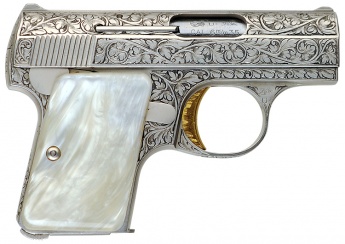


FN Baby Browning
| FN Baby Browning | |
|---|---|
| Type | Pistol |
| Place of origin | Belgium |
| Service history | |
| Used by | French Resistance, US Air Force |
| Wars | World War II |
| Production history | |
| Designer | John Browning Dieudonné Saive |
| Designed | 1927 |
| Manufacturer | Fabrique Nationale de Herstal Manufacture d’armes de Bayonne Precision Small Parts, Inc. Precision Small Arms, Inc. |
| Produced | 1931–present |
| Specifications | |
| Weight | 275 g (9.7 oz) |
| Length | 104 mm (4.1 in) |
| Barrel length | 53.6 mm (2.11 in) |
| Height | 72 mm (2.8 in) |
|
|
|
| Cartridge | .25 ACP 6.35mm |
| Action | Blowback-operated semi-automatic |
| Muzzle velocity | 230–500 m/s (750–1,640 ft/s) |
| Feed system | 6-round sealed bottom, flat follower magazine; a rounded follower and removable inner and outer bottom plates were incorporated in 1984 |
| Sights | Fixed iron notch and blade |
The Baby Browning manufactured starting from 1931 , is a small blowback-operated semi-automatic pistol designed by Dieudonné Saive based on a design by John Browning (among Browning’s last designs) and chambered in .25 ACP (6.35×16mmSR).
The pistol features a six-round magazine capacity and is a striker-fired, single action, blowback mechanism. The manual thumb operated safety locks the slide in the closed position when engaged using side thumb pressure.[1]
Contents
History
FN produced under license the revolutionary model 1905 in 1906. Despite the name FN used for this pistol, it was later marketed as the “FN 1906”, the “V.P. .25” (V.P. denoting Vest Pocket), and most confusingly, the “Baby” model. This “Baby” pistol was later produced starting from 1931.
The 6.35x16mm .25 ACP cartridge became widely available. The term “ACP” stands for “Automatic Colt Pistol“. This cartridge was among the first automatic pistol cartridges to be utilized worldwide.
It was designed with a “semi-rimmed” shell casing made of brass. The rim of the shell casing had a slightly larger circumference than the base of the cartridge and an extractor groove was cut directly above it.
The shell casing head was spaced on this small rim; however, the utilization of the rim in this design complicated the mechanics of the cartridge because, while still in the magazine,
the rim of one cartridge would sometimes get hung up on the extractor groove of the following cartridge (also known as “rim lock”).[2]
The M 1905/FN 1906 Vest Pocket pistol (3 safety series) incorporated a grip safety mechanism that constituted the entire rear section of the grip and incorporated also a small safety lever on the left side of the receiver [( starting from the 3rd series only ] which locked the trigger.
In addition, this safety lever mechanism locked the slide about a half inch back from the front of the pistol to enable easy disassembly. FN also added this safety lever mechanism to its pistol, but did not add the magazine safety mechanism that Colt introduced in 1916.[3]
Design
Pressured by dozens of imitations and the proliferation of blatant unlicensed copies, FN began work in earnest on a successor product to the Model 1908 Vest Pocket pistol.
The basic Vest Pocket pistol design was used as a starting point for the new design. Dieudonné Saive (who would later design the Browning Hi-Power pistol and FN FAL rifle) was asked during 1926-1927 to design the new pistol.[3]
His design was smaller, lighter, and incorporated several refinements and improvements to the M1908 version.
For example, the hand palm activated grip safety mechanism was eliminated and the small safety lever on the left side of the receiver was extended under the grip.
so that the thumb of a right-handed shooter could easily engage and disengage it using pressure applied to the side of the safety lever – rather than pushing it down into the receiver- without having to release one’s grip on the pistol.
This improvement was at the cost of the slide hold-back feature that was eliminated in the new design. The receiver has a full-length dust guard extending to the end of the slide and an area behind the trigger is relieved to allow a user to maintain a more substantial grip on the pistol.
The Dieudonne Saive design also introduced a magazine safety mechanism similar to the one utilized on the Colt Vest Pocket pistol.
Parts are not interchangeable between these pistols.[4] A cocking indicator was also incorporated on the back of the slide.
This model was marketed under the name “Baby” – and some of the original thermal hardened plastic grips were molded with both the initials “FN” at the top of the grip in a circle and the word “BABY” at the bottom of the grip under a raised crescent.
This particular pistol was and continues to be known worldwide as the “Baby Browning” pistol and is the pistol reflected in the picture accompanying this article, excepting the BROWNING marked grip which indicates a more recent (circa 1960 and beyond) production run utilizing nylon impregnated polymer grips.[2]
Manufacturing history
European-based production
FN manufactured and marketed the Baby Browning pistol from 1931 until 1979, though exports to the USA only took place between 1953-1968. About 500,000 units were produced, including the hand chiseled engraved “Renaissance” and the “Lightweight” version.
The Lightweight utilized a 6061 T6 aluminum receiver and chrome-plated (over electroless nickel) slide and external detail parts.
This particular version of the Baby Browning pistol was developed and marketed in commemoration of the Concorde supersonic jet which was introduced to the public circa 1965.
With the exception of special order nickel-plated units and the above-mentioned custom built pistols, all of the Baby Browning pistols were finished in hot blue.
The halt to exports to the USA in 1968 was dictated by the Gun Control Act of 1968 which was precipitated by Robert Kennedy’s assassination involving an Iver Johnson made revolver and signed into law by then President Lyndon Johnson.
This federal legislation forbade the importation of certain firearms, among them the Baby Browning pistol. FN transferred production of the Baby Browning pistol to Manufacture d’armes de Bayonne(“MAB”) during 1979.
Based in France, MAB produced the pistol from 1979 until 1983 when bankruptcy forced it to shut down. Baby Browning pistol production ceased in Europe at that time and has not been revived.[2]
North American–based production – FN-sponsored
During 1982, discussions began between FN and its North American-based representative Jim Stone.
These discussions were focused on securing a North American-based manufacturer for the Baby Browning pistol.
In 1984, a Canadian Swiss screw machine shop with a world class reputation for producing aerospace and defense related components entered into a technology transfer and production agreement with FN.
This company’s name was Precision Small Parts, Ltd. It was based in Aurora, Ontario, Canada, and maintained a subsidiary in Charlottesville, Virginia.
FN issued an order to PSP for 40,000 of the Baby Browning pistols. All of these pistols were to be exported to Austria under the Browning logo for re-distribution by FN to its non-USA customers.
PSP’s owner (Joseph Maygar Sr.) had a long working history with FN dating back to the days of the Hungarian Resistance Movement of WWII. PSP produced other firearms for FN, including sub-machine gun parts.
In 1985, the Canadian authorities forced PSP to transfer production of the Baby Browning receiver to its Virginia facility, though PSP Ltd. continued to manufacture the slide and detail parts for the pistol, excepting the magazine which was contracted out to Mec-Gar of Italy.
When the USA subsidiary of PSP applied for an export permit with the Department of State to transfer the pistols to FN via its Austrian contact, the export permit was denied.
At that time, Austria was known to be a transshipment point for armaments for the Middle East and the presumption was and remains that State did not want a large number of Baby Browning pistols ending up in the Middle East at that time.
The effect of this action on the part of State caused PSP to become insolvent (as it had amassed work in process of in excess of 40,000 Baby Browning part sets).
The insolvency of the company precipitated a sale to a USA/Canadian-based investor group in 1991. During 1995 the production of the pistol was spun out by the investor group into a new entity which became known as Precision Small Arms (PSA).[5]
PSA currently produces several models, including presentations grade examples with gold engraving, alongside other fine materials. PSA is a “one-man operation”, with 2 employees as of 2016.
The PSA .25 is currently produced using CNC machining, with all parts hand-fitted to assure near perfection in fit and finish. PSA introduced a 303 stainless steel version of the pistol in 2008; in 2009 it re-introduced an all billet version of the Lightweight renamed the Featherweight which utilizes a 7075 drop forged aluminum alloy receiver.
As of the beginning of 2010 all of PSA’s 19 versions of the Baby Browning were being manufactured from billet.[5]
North American–based production – non-FN-sponsored
From 1972 until 1984, a company named Bauer Firearms of Fraser, Michigan from 1972–1984 manufactured and marketed an unlicensed copy of the Baby Browning pistol which was machined from 416 stainless steel.[6]
The pistol was marketed as the Fraser-25 from 1984 to 1986.[7]
This pistol was an approximate copy of the Baby Browning and was designed as such in order to avoid copyright infringement claims from FN, which at that time still had US patent protection on various components of the Baby Browning pistol.
For example, the Bauer copy was produced using 416 stainless steel investment castings while the FN Baby Browning slide and receiver were originally produced from 8620 steel billet, though in the 1950s were produced from 8620 steel investment castings.[8]
The Bauer utilized a different auto safety spring and the barrel was removed (and the slide released from the receiver) by twisting it clockwise 45 degrees from top dead center, rather than counterclockwise, as is the case with the Baby Browning pistol.
The Bauer has engraving on both sides of the slide, whereas the FN Baby Browning has engraving only on the side of the slide opposite the ejection port side.[7]












The 10 MM pistols & rounds

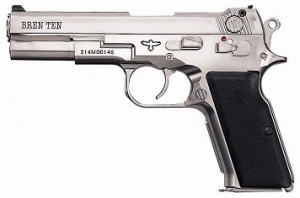

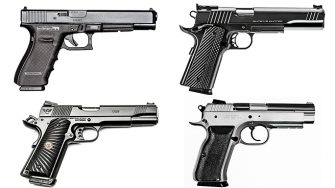

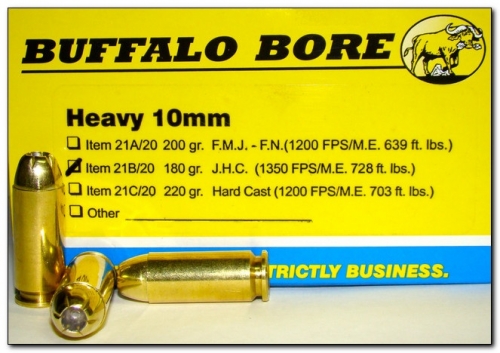
Now I have shot this round in a couple of pistols while on this 3rd rock from the sun. Frankly I was not overly impressed with it.
Since I really could not tell the difference between it and the 45 acp. While it’s nice and all but I have decided to give it the pass. Since the ammo at least for me is EXPENSIVE and very hard to find out here in La La Land.
Take this for what its worth!
Grumpy
The Long Slide Pistols


Now I can understand this idea very easily. Since like everything else here in the USofA. We are always looking to enhance and improve everything possible.
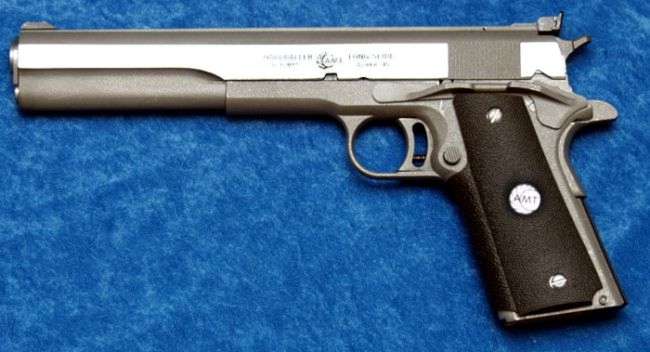
So why not take an semi automatic pistol and increase its length. Then according to that theory . It will have a longer sighting area thus improving its accuracy.

Also the longer length will help increase the ignition of the powder charge. That then increases the velocity/ range / hitting power of the bullet. So off it went to town !
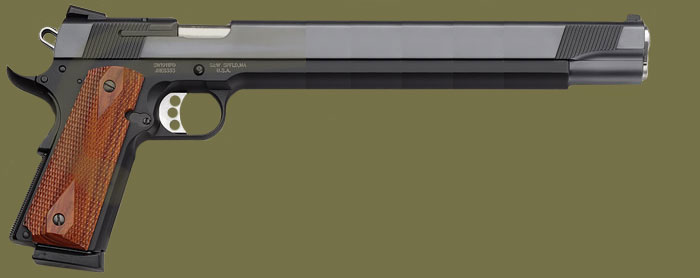
Here is some more information about the results.
Enjoy!
Grumpy


